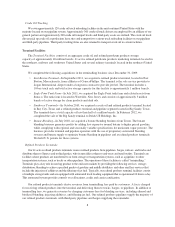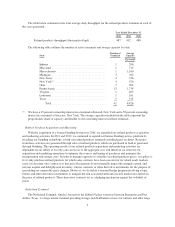Sunoco 2012 Annual Report Download - page 20
Download and view the complete annual report
Please find page 20 of the 2012 Sunoco annual report below. You can navigate through the pages in the report by either clicking on the pages listed below, or by using the keyword search tool below to find specific information within the annual report.Environmental Remediation
Contamination resulting from releases of refined products and crude oil is not unusual within the petroleum
pipeline industry. Historic releases along our pipelines, gathering systems, and terminals as a result of past
operations have resulted in impacts to the environment, including soils and groundwater. Site conditions,
including soils and groundwater, are being evaluated at a number of properties where operations may have
resulted in releases of hydrocarbons and other wastes. Sunoco has agreed to indemnify us from environmental
and toxic tort liabilities related to the assets transferred to the extent such liabilities existed or arose from
operation of these assets prior to the closing of the February 2002 IPO and are asserted within 30 years after the
closing of the IPO. This indemnity will cover the costs associated with performance of the assessment,
monitoring, and remediation programs, as well as any related claims and penalties. See “Environmental
Regulation—General.”
We have experienced several petroleum and refined product releases for which we are not covered by an
indemnity from Sunoco, and for which we are responsible for necessary assessment, remediation, and/or
monitoring activities. Our management estimates that the total aggregate cost of performing the currently
anticipated assessment, monitoring, and remediation activities at these sites is not material in relation to our
operations, financial position or cash flows at December 31, 2012. We have implemented an extensive inspection
program to prevent releases of refined products or crude oil into the environment from our pipelines, gathering
systems, and terminals. Any damages and liabilities incurred due to future environmental releases from our assets
have the potential to substantially affect our business and our ability to generate the cash flow necessary to make
distributions or satisfy debt obligations.
Rate Regulation
General Interstate Regulation
Interstate common carrier pipeline operations are subject to rate regulation by the FERC under the Interstate
Commerce Act, the Energy Policy Act of 1992, and related rules and orders. The Interstate Commerce Act
requires that tariff rates for petroleum pipelines be “just and reasonable” and not unduly discriminatory. This
statute also permits interested persons to challenge proposed new or changed rates and authorizes the FERC to
suspend the effectiveness of such rates for up to seven months and to investigate such rates. If, upon completion
of an investigation, the FERC finds that the new or changed rate is unlawful, it is authorized to require the carrier
to refund revenues in excess of the prior tariff during the term of the investigation. The FERC also may
investigate, upon complaint or on its own motion, rates that are already in effect and may order a carrier to
change its rates prospectively. Upon an appropriate showing, a shipper may obtain reparations for damages
sustained for a period of up to two years prior to the filing of a complaint.
The FERC generally has not investigated interstate rates on its own initiative when those rates, like those we
charge, have not been the subject of a protest or a complaint by a shipper. However, the FERC could investigate
our rates at the urging of a third party if the third party is either a current shipper or has a substantial economic
interest in the tariff rate level. Although no assurance can be given that the tariffs charged by us ultimately will
be upheld if challenged, management believes that the tariffs now in effect for our pipelines are within the
maximum rates allowed under current FERC guidelines.
We have been approved by the FERC to charge market-based rates in most of the refined products locations
served by our pipeline systems. In those locations where market-based rates have been approved, we are able to
establish rates that are based upon competitive market conditions.
Intrastate Regulation
Some of our pipeline operations are subject to regulation by the Texas R.R.C., the PA PUC, and the OCC.
The operations of our joint venture interests are also subject to regulation in the states in which they operate. The
18
























